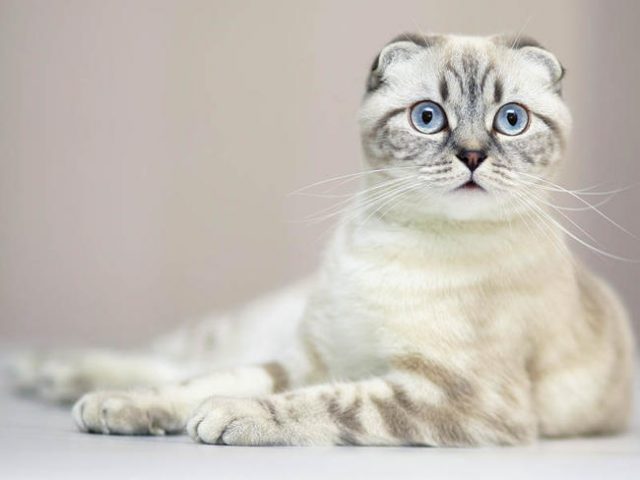Type the name of the breed you're looking for below
[wpdreams_ajaxsearchlite] Don't see the breed your're looking for? Click here and let us know!
Breed Characteristics
1 paw - breed exhibits the least amount of this characteristic
5 paws - breed exhibits most amount of this characteristic
Scottish Fold
| Origin And History | In 1961 Scottish shepherd William Ross noticed a white cat with strange, folded ears at a neighbor's farm near Coupar Angus in the Tayside Region of Scotland. Realizing the uniqueness of this cat's 'lop' ears, he asked around and found that the feline was a barn cat of no particular pedigree. Named Suzie, the cat belonged to Ross's neighbors, the McRaes. Ross learned that Susie's mother was a straight-eared white cat. Her father was unknown, so it was unclear whether Susie was the first of her kind, or whether the folded ears had simply never been noticed before. Susie's brother was also a Fold, but he wandered away, never to be seen again. Ross and his wife, Mary, were enchanted by the feline and when Susie produced two folded ear kittens a year later, they acquired one, a white beauty like her mother whom they named Snooks. The Rosses started a breeding program and proceeded to investigate establishing a new breed by attending cat shows and talking with breeders. At this time, they called the breed 'lop-eared', after the rabbit variety. In 1966 the Rosses began registering their cats with the Governing Council of the Cat Fancy and, along with other enthusiasts, began the long process of achieving acceptance for their folded friends. By the end of the decade the breed was renamed the Scottish Fold. In the early 1970s, however, the GCCF stopped registering Folds because of concerns about ear disorders such as infections, mites, and hearing problems. To continue in the show ring, the Scottish Fold had to give up its kilts and bagpipes and move to America. Folds were first introduced to the United States in 1970 when three of Snook's kittens were sent to Dr. Neil Todd at the Carnivore Genetics Research Center in Massachusetts, who was researching spontaneous mutations. He eventually abandoned his research, but located homes for his Folds. One of his cats found his way to Salle Wolfe Peters in Pennsylvania, who is chiefly responsible for developing the breed in the United States. Other Folds were later imported to the United States. All genuine Scottish Folds can be traced back to Susie's line. The Scottish Fold was accepted for CFA registration in 1973; in 1978 it received Championship status. In an amazingly short period, the Fold earned acceptance in all the cat associations and a place in the U.S. cat fancy's top ten most popular breeds. |
| Personality | Scottish Folds, whether with folded ears or with normal ears, are typically good-natured and placid and adjust to other animals within a household extremely well. They tend to become very attached to their human caregivers and are by nature quite affectionate. Folds also receive high marks for playfulness, grooming and intelligence. These animals like to be outdoors and enjoy outdoor games and activities very much. Loneliness is something they heavily dislike and which makes them feel depressed. It is also common for Scottish Folds to be stubborn. |
Physical Attributes
| Appearance | The Scottish Fold's folded ears are produced by a dominant gene that affects the cartilage of the ears, causing the ears to fold forward and downward, giving the head a rounded appearance. Since the gene is dominant, all Scottish Fold cats must have at least one folded ear parent to have folded ears themselves. When a Fold is bred to a straight-eared cat, approximately 50 percent of the kittens will have folded ears, although the number of Folds in any given litter can vary greatly. Breeding Fold to Fold increases the number of Fold kittens, but also greatly increases the chances of skeletal deformities. Homozygous Folds (Folds that inherit the folded ear gene from both parents) are much more likely to develop congenital osteodystrophy, a genetic condition that causes crippling distortion and enlargement of the bones. Avoiding Fold-to-Fold breeding reduces the problem; however, controversy surrounds the breed because of this defect. Thickness or lack of mobility of the legs or tail are sure signs of trouble. You can determine tail flexibility by moving your hand down the tail in a very gentle, slightly upward-arching movement. All Folds are born with straight ears. At around three weeks the ears begin to fold, if they are going to. Since it's not readily apparent how many Folds one has, breeders must play a waiting game until the ears develop their final folds. Even then it's difficult to tell if the folds will be the tight folds preferred in the show ring or the looser, pet-quality folds. Despite being folded, the ears are still expressive and swivel to listen, lay back in anger, and prick up when the can opener whirrs. The fold in the ear can become less pronounced when the cat is in heat, upset, or ill. Although some Fold owners report an increased production of wax buildup in their cats' ears, apparently the folded ears do not make the cat more susceptible to mites or infections. The previously reported susceptibility to deafness may be related to the fact that many early Scottish Folds were white, and white cats can be prone to deafness unrelated to the fold gene. |
| Health | The typical lifespan of a Scottish Fold is 15 years. Scottish folds are susceptible to polycystic kidney disease (PKD) and cardiomyopathy. |



